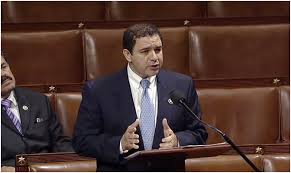
Artificial intelligence part of federal customer service push into the digital world
A report from the Partnership for Public Service and Accenture Federal Services found that data, governance, communication and engagement, and workforce managem...
The Education Department’s Federal Student Aid employees keep an eye on students headed toward default. In some states, people can register online for a replacement Social Security card. U.S. Citizenship and Immigration Services has Emma, a virtual assistant with artificial intelligence, who helps applicants who are literally and figuratively lost in translation.
These agencies use information, administration and communication to improve customer service — models that all of the federal government should be following, according to a report released Feb. 23 by the Partnership for Public Service and Accenture Federal Services.
The report includes four main challenges agencies need to address:
- Data
- Governance
- Communication and engagement
- Workforce management
“There is a lot of interdependency, you really need to do all these things to have a lasting, meaningful impact on customer experience,” said Kathy Conrad, director of digital government at Accenture, and a former General Services Administration executive in the Office of Citizen Services and Integrated Technologies.
The report, titled “Government for the People,” is based on surveys and interviews with nearly 50 federal customer service experts across 12 agencies.
“If you are the only one talking about this, and you are the only one pushing customer focus, there is a systemic, organizational leadership issue,” said Brenda Wensil, chief customer experience officer for Federal Student Aid, during a panel discussion Feb. 23 at the partnership’s Washington office. “What we run into, you’ve got competing priorities: You’ve got to run the business but at the same time you’ve got to figure out how to integrate the most impactful, high-return initiatives for the customer in the same process. Sometimes you win a few, sometimes you have to wait.”
President Barack Obama has focused on customer service, signing an executive order in 2011, and making it a cross-agency priority goal.
Now the administration plans to launch a governmentwide initiative to establish a federal services council that draws on the expertise and lessons learned of about 15 agencies and about 30 customer-facing programs, according to an official from the Office of Management and Budget.
These initiatives are part of the Obama administration’s attempt to address long-standing challenges around customer service. The American Customer Service Index found satisfaction in the government as a whole sank to 63.9 percent in 2015, compared to the previous record low of 64.4 percent in 2014.
While the governmentwide rating has dropped, individual agencies continue to make substantial progress.
Wensil said FSA is developing how it uses data to help struggling students headed toward default.
“Are there students headed for trouble?” Wensil asked. “Can we intercede and change the course of action?”
Wensil joined FSA in 2010 as the first-ever customer experience officer within the federal government.
“We’re fairly close to the public we serve,” Wensil said. “We hold ourselves accountable to keeping the conversation going about what is important to consumers. What are they saying, what are their problems? Then as a group how do we address that across the operating community?”
Lost in translation
Mariela Melero, the associate director of customer service and public engagement for USCIS, told the audience gathered for the panel that regardless of how someone might feel about immigration policy, when it comes to her agency, “We are here because at the end of the day, we need to provide the service that ultimately continues to fuel the organization.”
She added the agency handles 6 million to 7 million transactions each year.
“We’re not in the business of collecting. We’re not in the business of giving. We’re in the business of delivering services to individuals who pay for them,” Melero said.
But those services can be involved in a very important action in a person’s life, such as becoming a citizen, working in America or going back to one’s home country, Melero said.
“We have customers who are lost in translation, who have absolutely no idea what they want to do, what they can do,” Melero said.
The agency created an online platform where customers can search the website and find applications and forms, like they would on Google, or ask a question of the agency’s artificial intelligence option called Emma (named for Emma Lazarus, who’s sonnet “The New Colossus,” appears on the Statue of Liberty).
USCIS launched the program in December and Emma speaks “a very immigration-centric” and “very customer-centric” language that helps people with specific questions about immigration, but only in English, Melero said. But in about 2 months, Emma also will speak Spanish.
“How’d we get to this point? By engaging directly with the customers, by having them feed questions into Emma, and by having them interact with Emma,” Melero said.
Constantly changing and training
Carolyn Colvin, acting commissioner for the Social Security Administration, said for her agency, “customer service is our DNA.”
“It’s part of our mission statement,” Colvin said. “Our customers don’t have the option of going elsewhere.”
SSA handles the wages of more than 170 million people and manages 60 million beneficiaries, Colvin said.
“We are constantly having to modify the way in which we do things,” Colvin said, adding that SSA also has five generations of employees working for the agency, which means constantly training staff so they understand how to address the changing needs of the public.
Colvin said SSA is moving toward more online services because customers have told the agency that’s where they want to conduct their business.
One way the agency is doing this is by offering people in certain states the option of applying online for a replacement Social Security card. About 4 million people come into the field offices with requests for those cards, Colvin said.
The customer service focus from SSA, USCIS and FSA are part of the administration’s broader effort to improve federal customer service. In addition to the new council, the White House introduced customer service awards for agencies in 2015. The administration announced initial winners in December, highlighting the work of two individuals and three programs.
Customer service also is a cross-agency priority goal. OMB updated agency progress for the fourth quarter of fiscal 2015 detailing progress against a host of objectives.
OMB also plans on developing a federal customer service-focused website and developing a customer service playbook and maturity model by the second quarter of 2016.
Copyright © 2024 Federal News Network. All rights reserved. This website is not intended for users located within the European Economic Area.



